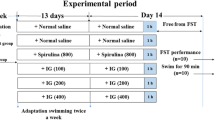Abstract
Objective
To ascertain anti-fatigue constituents and mechanisms of Herpetospermum caudigerum.
Methods
The 80% ethanol extracts of Herpetospermum caudigerum were partitioned with chloroform, ethyl acetate and n-butanol, respectively. Male Kunming mice were divided into 13 groups with 16 mice in each group: a control group fed with water, 9 groups treated with 3 fractions of Herpetospermum caudigerum (chloroform fraction, ethyl acetate fraction and n-butanol fraction) at dose of 80, 160 and 320 mg/kg for the low-dose group, medium-dose group and high-dose group, 3 herpetrione (HPE) treated groups fed with HPE at dose of 15, 30, and 60 mg/kg for the low-dose group, medium-dose group and high-dose group. All animals were treated once per day for 30 days. Anti-fatigue activity was assessed through the forced swimming test and serum biochemical parameters including blood lactic acid (BLA), blood urea nitrogen (BUN), malondialdehyde (MDA), hepatic glycogen (HG), lactic dehydrogenase (LDH), superoxide dismutase (SOD) and glutathione peroxidase (GPx) determined following the recommended procedures provided by the commercial kits.
Results
Compared with the control group, the lignans extract (ethyl acetate fraction) of Herpetospermum caudigerum and HPE could signifificantly prolonged the exhaustive swimming time (P<0.05 or P<0.01), and also increased the HG levels (P<0.05 or P<0.01) and the activities of antioxidant enzymes (SOD, GPx and LDH, P<0.05 or P<0.01); BLA and MDA levels were decreased considerably in lignans extract and HPE treated groups (P<0.05 or P<0.01). HPE also could significantly decrease the BUN contents compared with the control group (P<0.05). The chloroform and n-butanol fraction showed no effect on swimming time and biochemical parameters.
Conclusions
The lignans extract had antifatigue activities and HPE may be partly responsible for the anti-fatigue effects of Herpetospermum caudigerum. The possible mechanisms of anti-fatigue activity were related to the decrease of BUN and BLA, the increase of the HG storage and protecting corpuscular membrane by preventing lipid oxidation via modifying several enzyme activities.
Similar content being viewed by others
References
Fitts RH. Cellular mechanisms of muscle fatigue. Physiol Rev 1994;74:49–94.
Wang L, Zhang HL, Lu R, Zhou YJ, Ma R, Lv JQ, et al. The decapeptide CMS001 enhances swimming endurance in mice. Peptides 2008;29:1176–1182.
You LJ, Zhao MM, Regenstein JM, Ren JY. In vitro antioxidant activity and in vivo anti-fatigue effect of loach (Misgurnus anguillicaudatus) peptides prepared by papain digestion. Food Chem 2011;124:188–194.
Zheng X, Long W, Liu G, Zhang X, Yang X. Effect of seabuckthorn (Hippophae rhamnoides ssp. sinensis) leaf extract on the swimming endurance and exhaustive exercise-induced oxidative stress of rats. J Sci Food Agric 2012;92:736–742.
Wu Z, ed. The flora of Tibet. Beijing: Science Press; 1985:537.
Yuan HL, Liu Y, Zhao YL, Xiao XH. Herpetin,a new bioactive lignan isolated from Herpetosprmum caudigerum. J Chin Pharm Sci 2005;14:140–143.
Cong LB, Yuan HL, Wang Q, Li XY, Gong QF, Xiao XH. Simultaneous determination of seven bioactive lignans in Herpetospermum caudigerum by RP-HPLC method. Biomed Chromatogr 2008;22:1084–1090.
Yuan HL, Yang M, Li XY, You RH, Liu Y, Zhu J, et al. Hepatitis B virus inhibiting constituents from Herpetospermum caudigerum. Chem Pharm Bull 2006;54:1592–1594.
Fang QM, Zhang H, Cao Y. Anti-oxidant activities of the seed extracts of Herpetospermum pedunculosum against liver injury in rats. West China J Pharm 2008;2:147–149.
Wu Q, Yuan HL, Li XY, Zhao YL, Cao L. Protective effect of Ganneng Dripping Pills on experimental hepatic injury in mice. Pharm J Chin PLA (Chin) 2005;21:127–128.
Wang LY, Unehara N, Kitanaka S. Lignans from the roots of Wikstroemia indica and their DPPH radical scavenging and nitric oxide inhibitory activities. Chem Pharm Bull 2005;53:1348–1351.
Jin SY, Lu JL, Yuan HL, Jin SX, Fu SS, Guo JJ. Studies on anti-fatigue and anoxia-resistant effects of Herpetospermum Caudigerum Extracts in mice. Pharm J Chin PLA (Chin) 2011:27:417–418.
Chen Y, Kong LD, Xia X, Kung HF, Zhang L. Behavioral and biochemical studies of total furocoumarins from seeds of Psoralea corylifolia in the forced swimming test in mice. J Ethnopharmacol 2005:96:451–459.
Zhang Y, Yao X, Bao B. Anti-fatigue activity of a triterpenoidrich extract from Chinese bamboo shavings (Caulis bamfusae in taeniam). Phytother Res 2006;20:872–876.
Tharakan B, Dhanasekaran M, Manyam BV. Antioxidant and DNA protecting properties of anti-fatigue herb Trichopus zeylanicus. Phytother Res 2005;19:669–673.
Huang LZ, Huang BK, Ye Q, Qin LP. Bioactivity-guided fractionation for anti-fatigue property of Acanthopanax senticosus. J Ethnopharmacol 2011;133:213–219.
Ding JF, Li YY, Xu JJ, Su XR, Gao X, Yue FP. Study on effect of jellyfish collagen hydrolysate on anti-fatigue and anti-oxidation. Food Hydrocol 2011;25:1350–1353.
Cairns SP. Lactic acid and exercise performance: culprit or friend? Sports Med 2006;36:279–291.
Dorchy H. Sports and type I diabetes: personal experience. Rev Med Brux 2002;23:211–217.
You Y, Park J, Yoon HG, Lee YH, Hwang K, Lee J, et al. Stimulatory effects of ferulic acid on endurance exercise capacity in mice. Biosci Biotechnol Biochem 2009;73:1392–1397.
Powers SK, De Ruisseau KC, Quindry J, Hamilton KL. Dietary antioxidants and exercise. J Sports Sci 2004;22:81–94.
Ji KT, Tang JF, Chai JD, Chen XY, Lin JF, Yang PL. Effect of astragaloside against the oxidative damage on endothelial progenitor cells. Chin J Integr Tradit West Med (Chin) 2011;31:807–810.
Jin HM, Wei P. Anti-fatigue properties of tartary buckwheat extracts in mice. Int J Mol Sci 2011;8:4770–4780.
Finaud J, Lac G, Filaire E. eds. Oxidative stress: relationship with exercise and training. Sports Med 2006;36:327–358.
Tan SJ, Yu Z, Dong QT, Zhang XD, Chen BC, Zhou F, et al. Effects of ginsenoside Rb1 on the oxidative stress in the skeletal muscles of rats with postoperative fatigue syndrome. Chin J Integr Tradit West Med (Chin) 2012;32:1535–1538.
Lenaz G. Role of mitochondria in oxidative stress and ageing. Biochim Biophys Acta 1998;1366:53–67.
Author information
Authors and Affiliations
Corresponding author
Additional information
Supported by the National Key New Drugs Innovation Foundation (No. 2009ZX09103-349) and the Beijing Natural Science Foundation (No. 7122176)
Rights and permissions
About this article
Cite this article
Jin, Sy., Li, Rs., Shen, Bd. et al. Lignans-rich extract from Herpetospermum caudigerum alleviate physical fatigue in mice. Chin. J. Integr. Med. 22, 840–845 (2016). https://doi.org/10.1007/s11655-016-2254-2
Received:
Published:
Issue Date:
DOI: https://doi.org/10.1007/s11655-016-2254-2




